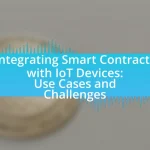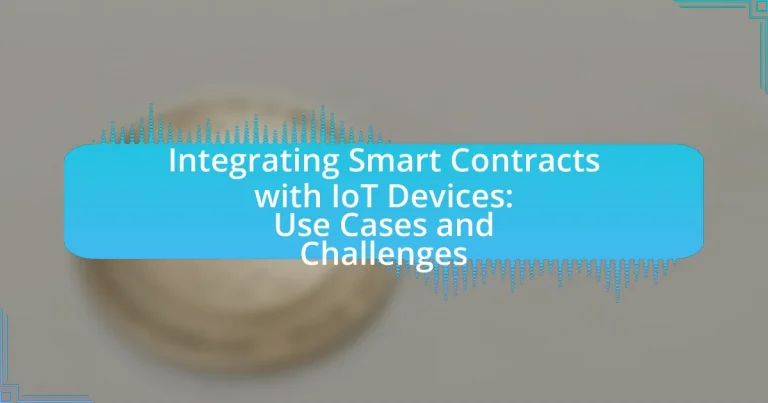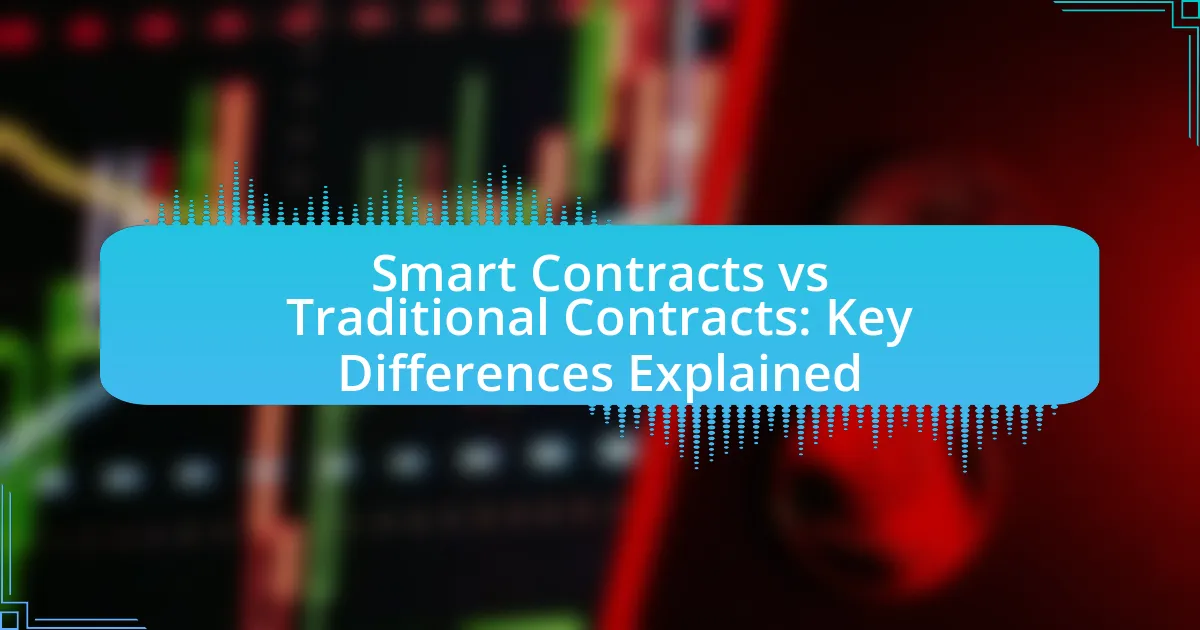The article focuses on the integration of smart contracts with Internet of Things (IoT) devices, highlighting their potential use cases and the challenges faced during this integration. Smart contracts are self-executing agreements coded on blockchain technology, enabling automated transactions and enhancing security by eliminating intermediaries. The article discusses how this integration can improve efficiency in various sectors, such as supply chain management, smart homes, and healthcare, while also addressing challenges like scalability, interoperability, and data privacy. Key features of smart contracts, their role in ensuring trust and security, and the implications for modern technology are also examined, providing a comprehensive overview of the current landscape and future prospects of this technological convergence.
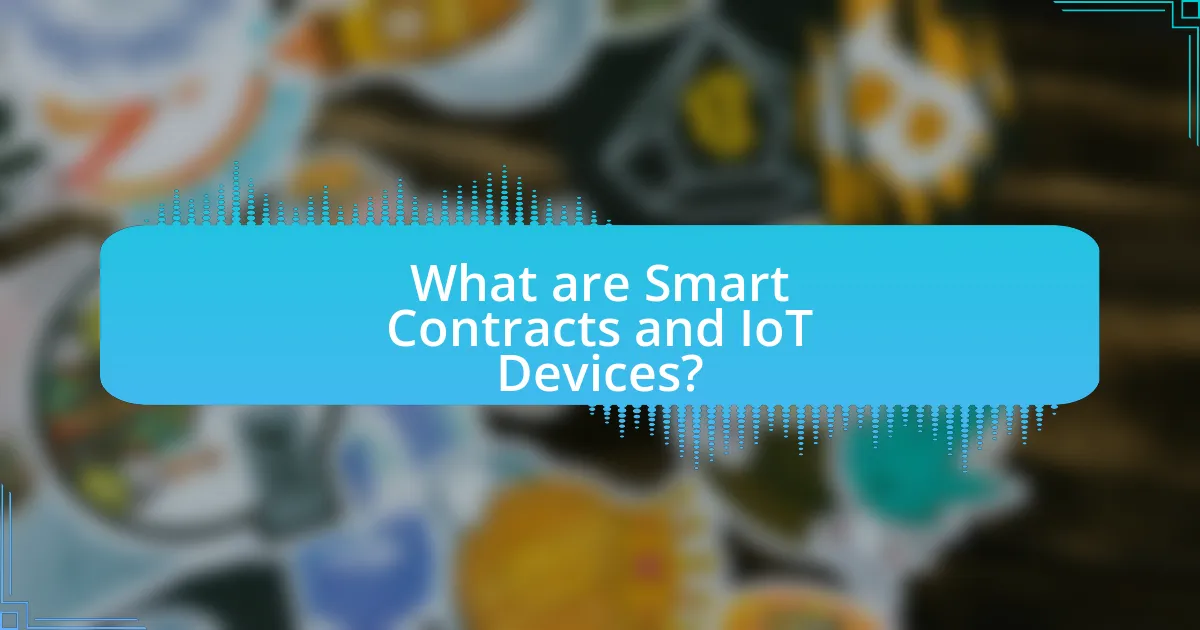
What are Smart Contracts and IoT Devices?
Smart contracts are self-executing contracts with the terms of the agreement directly written into code, enabling automated transactions on blockchain platforms. Internet of Things (IoT) devices are interconnected physical devices that collect and exchange data over the internet, allowing for remote monitoring and control. The integration of smart contracts with IoT devices facilitates automated processes, enhances security, and reduces the need for intermediaries in transactions, as evidenced by applications in supply chain management where smart contracts can automatically trigger actions based on data received from IoT sensors.
How do Smart Contracts function in a digital ecosystem?
Smart contracts function as self-executing agreements with the terms of the contract directly written into code, enabling automated transactions and processes within a digital ecosystem. They operate on blockchain technology, ensuring transparency, security, and immutability, which are essential for trust in decentralized environments. For instance, when predefined conditions are met, smart contracts automatically execute actions such as transferring assets or triggering other contracts without the need for intermediaries. This automation reduces the risk of human error and enhances efficiency, as evidenced by their application in various sectors, including finance and supply chain management, where they streamline operations and reduce costs.
What are the key features of Smart Contracts?
Smart contracts are self-executing contracts with the terms of the agreement directly written into code. Key features include automation, which eliminates the need for intermediaries, ensuring faster and more efficient transactions. They are also immutable, meaning once deployed on a blockchain, the contract cannot be altered, providing security and trust. Additionally, smart contracts are transparent, allowing all parties to view the contract terms, which enhances accountability. Finally, they are programmable, enabling complex agreements and interactions with other digital systems, such as IoT devices, to facilitate automated processes.
How do Smart Contracts ensure trust and security?
Smart contracts ensure trust and security by automating and enforcing agreements through code on a blockchain. This decentralized technology eliminates the need for intermediaries, reducing the risk of fraud and manipulation. The immutability of blockchain records guarantees that once a smart contract is deployed, its terms cannot be altered, ensuring that all parties adhere to the agreed-upon conditions. Additionally, the transparency of blockchain allows all participants to verify transactions, fostering accountability. According to a report by the World Economic Forum, by 2025, 10% of global GDP is expected to be stored on blockchain technology, highlighting its growing importance in secure transactions.
What role do IoT Devices play in modern technology?
IoT devices serve as critical components in modern technology by enabling seamless connectivity and data exchange between physical objects and digital systems. These devices collect and transmit data, facilitating real-time monitoring and automation across various sectors, including healthcare, agriculture, and smart cities. For instance, a report by Statista indicates that the number of connected IoT devices is projected to reach 30.9 billion by 2025, highlighting their growing significance in enhancing operational efficiency and decision-making processes.
What are the main types of IoT Devices?
The main types of IoT devices include sensors, actuators, smart appliances, wearables, and connected vehicles. Sensors collect data from the environment, such as temperature or humidity, while actuators perform actions based on that data, like adjusting a thermostat. Smart appliances, such as refrigerators and washing machines, connect to the internet for remote control and monitoring. Wearables, like fitness trackers, gather health-related data and provide insights to users. Connected vehicles integrate IoT technology for navigation, diagnostics, and safety features. These categories reflect the diverse applications of IoT technology across various sectors, enhancing automation and data-driven decision-making.
How do IoT Devices communicate with each other?
IoT devices communicate with each other primarily through wireless communication protocols such as Wi-Fi, Bluetooth, Zigbee, and cellular networks. These protocols enable devices to exchange data and commands, facilitating interoperability and coordination in various applications. For instance, Zigbee is commonly used in smart home devices due to its low power consumption and ability to create mesh networks, allowing devices to relay information over longer distances. Additionally, MQTT (Message Queuing Telemetry Transport) is a lightweight messaging protocol often employed in IoT environments for efficient data transmission between devices. This communication framework is essential for the integration of smart contracts with IoT devices, as it allows for real-time data sharing and automated decision-making based on predefined conditions.
Why is the integration of Smart Contracts with IoT Devices important?
The integration of Smart Contracts with IoT Devices is important because it enhances automation, security, and efficiency in transactions between devices. Smart Contracts enable IoT devices to execute agreements autonomously, reducing the need for intermediaries and minimizing human error. For instance, in supply chain management, Smart Contracts can automatically trigger payments when goods are delivered, ensuring timely transactions and reducing disputes. This integration also improves data integrity and trust, as the decentralized nature of Smart Contracts on blockchain technology ensures that all parties have access to the same information, thereby preventing tampering and fraud.
What potential benefits arise from this integration?
The integration of smart contracts with IoT devices offers enhanced automation, improved security, and increased efficiency. This synergy allows for automatic execution of agreements based on real-time data from IoT devices, reducing the need for intermediaries and minimizing human error. For instance, in supply chain management, smart contracts can automatically trigger payments when IoT sensors confirm the delivery of goods, streamlining operations and ensuring timely transactions. Additionally, the decentralized nature of blockchain technology, which underpins smart contracts, enhances data integrity and security, making it difficult for unauthorized parties to alter transaction records. This integration can lead to significant cost savings and operational improvements across various industries, including logistics, healthcare, and energy management.
How can this integration enhance automation and efficiency?
Integrating smart contracts with IoT devices enhances automation and efficiency by enabling autonomous decision-making and real-time data processing. This integration allows IoT devices to execute predefined actions based on specific conditions without human intervention, significantly reducing response times and operational delays. For instance, a smart contract can automatically trigger a payment when an IoT sensor detects that a delivery has been made, streamlining supply chain processes. According to a study by the International Journal of Information Management, organizations that implemented smart contracts with IoT reported a 30% increase in operational efficiency due to reduced manual processes and faster transaction times.
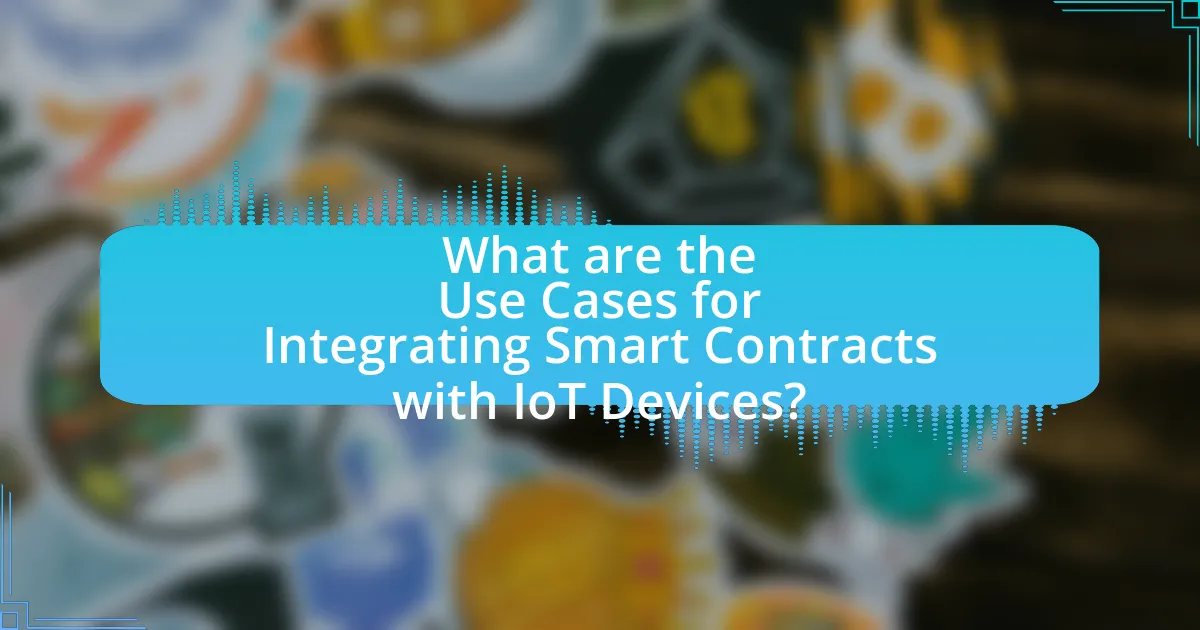
What are the Use Cases for Integrating Smart Contracts with IoT Devices?
Integrating smart contracts with IoT devices enables automated transactions and processes across various sectors. One prominent use case is in supply chain management, where smart contracts can automatically execute payments and track goods as they move through the supply chain, enhancing transparency and reducing fraud. Another use case is in smart homes, where smart contracts can manage energy consumption by automatically adjusting settings based on real-time data from IoT devices, optimizing energy use and costs. Additionally, in healthcare, smart contracts can facilitate secure sharing of patient data between devices and healthcare providers, ensuring compliance with regulations while improving patient care. These use cases demonstrate the potential for increased efficiency, security, and automation in various industries through the integration of smart contracts with IoT devices.
How can Smart Contracts improve supply chain management?
Smart contracts can improve supply chain management by automating processes, enhancing transparency, and reducing fraud. These self-executing contracts, built on blockchain technology, facilitate real-time tracking of goods and transactions, ensuring that all parties have access to the same information. For instance, a study by Accenture found that implementing blockchain and smart contracts in supply chains can reduce administrative costs by up to 30% and improve transaction speeds significantly. This automation minimizes human error and streamlines operations, leading to increased efficiency and reliability in supply chain activities.
What specific applications exist in logistics and tracking?
Specific applications in logistics and tracking include real-time shipment tracking, inventory management, and automated supply chain processes. Real-time shipment tracking utilizes GPS and RFID technology to provide accurate location data of goods in transit, enhancing visibility and reducing delays. Inventory management systems leverage IoT sensors to monitor stock levels and automate reordering processes, ensuring optimal inventory levels. Automated supply chain processes utilize smart contracts to facilitate transactions and agreements between parties, streamlining operations and reducing the need for intermediaries. These applications improve efficiency, reduce costs, and enhance transparency in logistics and tracking.
How do Smart Contracts facilitate transparency in supply chains?
Smart contracts facilitate transparency in supply chains by automating and securely recording transactions on a blockchain, ensuring that all parties have access to the same immutable data. This technology allows for real-time tracking of goods, as each transaction is logged and verified, reducing the risk of fraud and errors. For instance, a study by Accenture found that blockchain technology can reduce supply chain costs by up to 30% by enhancing visibility and accountability. By providing a shared ledger, smart contracts enable stakeholders to verify the authenticity and status of products at any point in the supply chain, thus fostering trust and collaboration among participants.
What are the implications for smart homes and buildings?
The implications for smart homes and buildings include enhanced automation, improved energy efficiency, and increased security. Smart homes utilize IoT devices to automate tasks such as lighting, heating, and security systems, leading to significant energy savings; for instance, a study by the U.S. Department of Energy found that smart thermostats can reduce heating and cooling costs by up to 10-15%. Additionally, integrating smart contracts with IoT devices can streamline operations and enhance security by enabling automated transactions and real-time monitoring, thereby reducing the risk of unauthorized access. These advancements not only improve user convenience but also contribute to sustainable living practices.
How can Smart Contracts automate home management systems?
Smart contracts can automate home management systems by executing predefined actions based on specific conditions without the need for intermediaries. For instance, smart contracts can manage energy consumption by automatically adjusting heating or cooling systems based on real-time data from IoT sensors, ensuring optimal energy use and cost savings. Additionally, they can facilitate automated payments for services like maintenance or utilities when conditions are met, such as the completion of a service or reaching a billing threshold. This automation reduces human error and enhances efficiency, as evidenced by studies showing that smart contracts can streamline processes in various sectors, including real estate and utilities, by providing transparent and tamper-proof transaction records.
What security benefits do Smart Contracts provide in smart environments?
Smart contracts provide enhanced security benefits in smart environments by automating and enforcing agreements without the need for intermediaries. This automation reduces the risk of human error and fraud, as the contract’s execution is based on pre-defined conditions coded into the blockchain. Additionally, the immutable nature of blockchain technology ensures that once a smart contract is deployed, it cannot be altered, which protects against tampering and unauthorized changes. Furthermore, smart contracts can facilitate secure transactions between IoT devices by ensuring that data integrity is maintained, as they can verify and validate the authenticity of data exchanged between devices. This combination of automation, immutability, and data integrity significantly enhances the overall security posture of smart environments.
How can Smart Contracts enhance healthcare through IoT Devices?
Smart contracts can enhance healthcare through IoT devices by automating data management and ensuring secure transactions. These self-executing contracts facilitate real-time data sharing between IoT devices, such as wearable health monitors, and healthcare providers, improving patient monitoring and treatment accuracy. For instance, when a patient’s vital signs exceed predefined thresholds, an IoT device can trigger a smart contract to automatically alert medical personnel, ensuring timely intervention. This integration reduces administrative overhead and minimizes errors associated with manual data entry, as evidenced by a study published in the Journal of Medical Internet Research, which highlights that automated systems can decrease processing time by up to 50%.
What are the use cases in patient monitoring and data sharing?
Use cases in patient monitoring and data sharing include remote health monitoring, chronic disease management, and real-time data analytics. Remote health monitoring allows healthcare providers to track patients’ vital signs and health metrics from a distance, improving access to care and timely interventions. Chronic disease management utilizes continuous data collection to adjust treatment plans based on real-time patient data, enhancing patient outcomes. Real-time data analytics enables healthcare professionals to make informed decisions quickly, optimizing resource allocation and improving overall healthcare efficiency. These use cases demonstrate the effectiveness of integrating smart contracts with IoT devices, facilitating secure and efficient data sharing while ensuring patient privacy and compliance with regulations.
How do Smart Contracts ensure data integrity in healthcare applications?
Smart contracts ensure data integrity in healthcare applications by automating and enforcing the rules of data access and transactions on a blockchain. This technology creates a tamper-proof record of all interactions, which means that once data is entered, it cannot be altered without consensus from all parties involved. For instance, a study published in the Journal of Medical Internet Research highlights that smart contracts can facilitate secure sharing of patient data among healthcare providers while maintaining compliance with regulations like HIPAA. This ensures that the data remains accurate and trustworthy, as any unauthorized changes would be immediately detectable due to the transparent nature of blockchain technology.
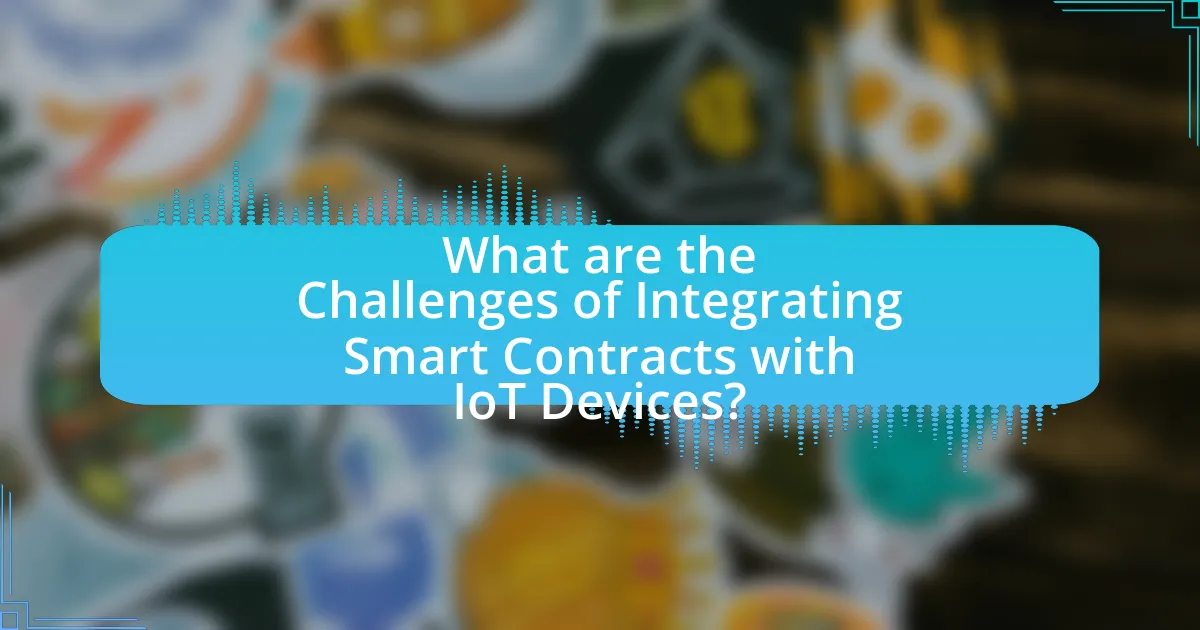
What are the Challenges of Integrating Smart Contracts with IoT Devices?
The challenges of integrating smart contracts with IoT devices include scalability, security, interoperability, and data privacy. Scalability issues arise because the number of IoT devices can be vast, leading to potential bottlenecks in processing transactions on blockchain networks. Security concerns stem from the vulnerability of IoT devices to hacking, which can compromise the integrity of smart contracts. Interoperability challenges exist as different IoT devices may operate on various protocols, making seamless communication difficult. Lastly, data privacy is a significant concern, as smart contracts often require access to sensitive information from IoT devices, raising issues regarding data protection and compliance with regulations such as GDPR.
What technical challenges arise during integration?
Technical challenges during integration of smart contracts with IoT devices include interoperability, scalability, and security. Interoperability issues arise because different IoT devices may use various communication protocols and data formats, making it difficult for smart contracts to interact seamlessly. Scalability challenges occur as the number of devices increases, leading to potential bottlenecks in processing transactions on the blockchain. Security concerns are heightened due to the vulnerability of IoT devices to hacking, which can compromise the integrity of the smart contracts. These challenges are well-documented in research, such as the study by Christidis and Devetsikiotis (2016) in “Blockchains and Smart Contracts for the Internet of Things,” which highlights the need for robust solutions to address these integration hurdles.
How do scalability issues affect Smart Contracts and IoT Devices?
Scalability issues significantly hinder the performance and efficiency of Smart Contracts and IoT Devices by limiting transaction throughput and increasing latency. Smart Contracts, which execute automatically on blockchain networks, face challenges when the number of transactions exceeds the network’s capacity, leading to slower processing times and higher fees. For instance, Ethereum, a popular platform for Smart Contracts, has experienced congestion during high-demand periods, resulting in transaction delays and increased costs.
Similarly, IoT Devices, which often require real-time data processing and communication, struggle to operate effectively when the underlying blockchain cannot handle the volume of data generated by numerous devices. This limitation can lead to bottlenecks, affecting the responsiveness and reliability of IoT applications. A study by the International Journal of Information Management highlights that scalability is a critical barrier to the widespread adoption of blockchain in IoT, as it directly impacts the ability to process large amounts of data efficiently.
What are the interoperability concerns between different IoT platforms?
Interoperability concerns between different IoT platforms primarily include compatibility of communication protocols, data formats, and security standards. Different IoT platforms often utilize proprietary protocols, making it challenging for devices from various manufacturers to communicate effectively. For instance, platforms may use MQTT, CoAP, or HTTP, which can lead to integration issues if not standardized. Additionally, varying data formats, such as JSON or XML, complicate data exchange and interpretation across platforms. Security standards also differ, creating vulnerabilities when devices from different ecosystems interact. According to a report by the International Telecommunication Union, the lack of common standards is a significant barrier to IoT interoperability, hindering seamless integration and functionality across diverse systems.
What legal and regulatory challenges must be addressed?
Legal and regulatory challenges that must be addressed include data privacy, liability issues, and compliance with existing laws. Data privacy concerns arise from the collection and processing of personal information by IoT devices, necessitating adherence to regulations such as the General Data Protection Regulation (GDPR) in Europe. Liability issues emerge when smart contracts execute transactions autonomously, raising questions about accountability in case of errors or breaches. Compliance with existing laws, including consumer protection and electronic transaction regulations, is essential to ensure that smart contracts operate within legal frameworks. These challenges require careful consideration to facilitate the integration of smart contracts with IoT devices effectively.
How do existing laws impact the use of Smart Contracts in IoT?
Existing laws significantly impact the use of Smart Contracts in IoT by establishing legal frameworks that govern their enforceability and compliance. For instance, regulations such as the General Data Protection Regulation (GDPR) in Europe impose strict data protection requirements that Smart Contracts must adhere to when processing personal data from IoT devices. Additionally, contract law varies by jurisdiction, affecting how Smart Contracts are interpreted and enforced, which can lead to legal uncertainties in cross-border IoT applications. Furthermore, intellectual property laws may influence the ownership and licensing of software used in Smart Contracts, thereby shaping their implementation in IoT ecosystems. These legal considerations necessitate careful design and implementation of Smart Contracts to ensure compliance and mitigate risks associated with legal disputes.
What are the privacy concerns related to data handled by Smart Contracts?
Privacy concerns related to data handled by smart contracts primarily involve the exposure of sensitive information on public blockchains. Smart contracts often operate on transparent platforms, meaning that any data processed or stored can be accessed by anyone, leading to potential data leaks. For instance, if personal data or proprietary business information is included in a smart contract, it can be viewed by unauthorized parties, violating privacy regulations such as GDPR. Additionally, the immutability of blockchain means that once data is recorded, it cannot be altered or deleted, raising concerns about the long-term implications of data exposure.
How can security vulnerabilities impact the integration process?
Security vulnerabilities can significantly hinder the integration process by exposing systems to unauthorized access and data breaches. When integrating smart contracts with IoT devices, vulnerabilities such as weak authentication protocols or insecure communication channels can lead to exploitation by malicious actors. For instance, a study by the Internet of Things Security Foundation highlights that 70% of IoT devices are susceptible to attacks due to inadequate security measures. This can result in compromised data integrity and loss of trust in the integrated system, ultimately delaying deployment and increasing costs associated with remediation efforts.
What are the common security threats faced by Smart Contracts and IoT Devices?
Smart contracts and IoT devices face several common security threats, including vulnerabilities to hacking, data breaches, and unauthorized access. Hacking can occur due to flaws in the smart contract code or insecure IoT device firmware, allowing attackers to manipulate contract execution or gain control over devices. Data breaches often arise from inadequate encryption and authentication measures, exposing sensitive information to malicious actors. Unauthorized access can result from weak passwords or default credentials, enabling attackers to exploit both smart contracts and IoT devices. According to a report by the Cybersecurity and Infrastructure Security Agency (CISA), these vulnerabilities can lead to significant financial losses and compromise user privacy, highlighting the critical need for robust security measures in both domains.
How can these vulnerabilities be mitigated effectively?
To effectively mitigate vulnerabilities in integrating smart contracts with IoT devices, implementing robust security protocols is essential. This includes utilizing encryption techniques to secure data transmission, ensuring that all communications between IoT devices and smart contracts are encrypted to prevent unauthorized access. Additionally, employing regular security audits and vulnerability assessments can identify potential weaknesses in the system before they can be exploited. According to a study by Zhang et al. (2020) in the journal “IEEE Internet of Things,” the application of blockchain technology in IoT can enhance security by providing a decentralized and tamper-proof ledger, which further reduces the risk of vulnerabilities.
What best practices should be followed for successful integration?
Successful integration of smart contracts with IoT devices requires adherence to several best practices. First, ensure robust security measures are implemented to protect data integrity and privacy, as IoT devices are often vulnerable to cyber threats. According to a report by the World Economic Forum, 60% of IoT devices have serious vulnerabilities, highlighting the need for strong encryption and secure communication protocols.
Second, establish clear interoperability standards to facilitate seamless communication between different devices and platforms. The Industrial Internet Consortium emphasizes that standardized protocols can reduce integration complexity and enhance device compatibility.
Third, implement a scalable architecture that can accommodate the growing number of IoT devices and transactions. Research from Gartner indicates that by 2025, there will be over 75 billion connected devices, necessitating scalable solutions to handle increased data flow and processing demands.
Lastly, conduct thorough testing and validation of smart contracts before deployment to ensure they function as intended in real-world scenarios. A study by the Ethereum Foundation found that 34% of smart contracts contain bugs, underscoring the importance of rigorous testing to prevent failures post-integration.
How can organizations prepare for the future of Smart Contracts and IoT integration?
Organizations can prepare for the future of Smart Contracts and IoT integration by investing in robust cybersecurity measures and developing a clear understanding of blockchain technology. Cybersecurity is critical as the integration of IoT devices increases the attack surface for potential breaches; according to a report by Cybersecurity Ventures, cybercrime is projected to cost the world $10.5 trillion annually by 2025. Additionally, organizations should focus on training their workforce on blockchain and smart contract functionalities to ensure effective implementation. A study by Deloitte indicates that 40% of organizations are already investing in blockchain technology, highlighting the importance of staying competitive in this evolving landscape. Furthermore, establishing partnerships with technology providers can facilitate smoother integration processes and access to innovative solutions.





